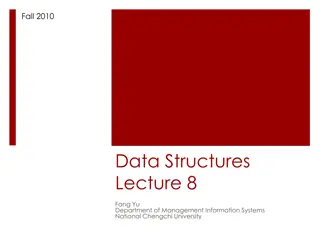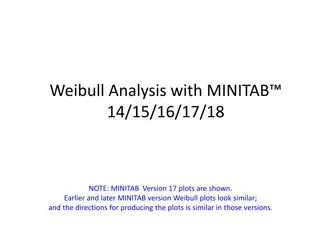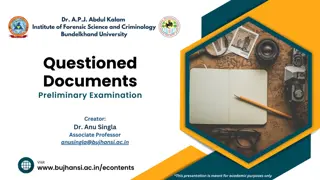Latent Print Analysis
Explore the comprehensive training materials for latent print analysis, covering topics such as fingerprint formation, identification methods, AFIS technology, collection techniques, and practical lab exercises. Gain insights into the importance of fingerprints, their unique features, and historical significance in forensic investigations. Enhance your knowledge in this critical aspect of crime scene investigation.
Download Presentation
Please find below an Image/Link to download the presentation.
The content on the website is provided AS IS for your information and personal use only. It may not be sold, licensed, or shared on other websites without obtaining consent from the author. Download presentation by click this link. If you encounter any issues during the download, it is possible that the publisher has removed the file from their server.
- Latent print analysis
- Forensic science
- Fingerprint identification
- Crime scene investigation
- Training materials
Presentation Transcript
CSI Unit Training Materials Latent Print Latent Print Analysis Analysis T. Tomm Updated 2023 https://sciencespot.net T. Tomm 2007 Updated 2023 https://sciencespot.net/
Part A: Watch the video to answer these questions. 24 weeks 1 How soon do fingerprints form in a fetus? 2 True or False? Identical twins have identical fingerprints. 3 What are the parts of a fingerprint? Ridges lines Valleys spaces between them 4 Why do we have fingerprints? To grasp objects (also called friction ridges) 5- True or False? No two people have the same fingerprints. People may have the same patterns, but not the exact same ridge features in the exact same places. 6 In which century were fingerprints first used as evidence? 19th Century
2. LATENT PRINTS are impressions left by friction ridge skin on a surface, such as a tool handle, glass, door, etc. 3. What is AFIS? How is it used? AFIS = AUTOMATED FINGERPRINT IDENTIFICATION SYSTEM Used to match fingerprints to identify victims or suspects. AFIS Video
4. How can latent prints be collected? a) BLACK or MAGNETIC powder can be used, which works better on shiny surfaces or plastic containers. b) FLUORESCENT powder and UV lights can find latent prints on multi- colored or dark surfaces. c) CYANOACRYLATE fuming method (often called the super glue method) is a procedure that is used to develop latent fingerprints on a variety of objects. d) NINHYDRIN is a chemical that bonds with the amino acids in fingerprints and will produce a blue or purple color. It is used to lift prints from surfaces such as paper and cardboard.
LAB DIRECTIONS Before we begin You need to clean up any spills immediately! Dust everything on the paper! Don t dust anything without permission! Materials Each TABLE needs a LIFTING KIT magnetic black powder, magnetic applicators, and clear tape. Each PERSON needs a CD and INDEX CARD. Put your NAME on the card! You will turn it in at the end of class. Goal - Lift at least 4 GOOD fingerprints. (You will have more time on Monday to finish!)
DIRECTIONS: Press the pad of your right thumb on a CD to make a print. Place the CD on the paper. Dip a brush lightly into the container of black powder and tap off the extra. You only need a very small amount of powder on the brush to dust the print. Hold the brush over the print and gently swipe over the print you want to process. Use the brush to remove any extra powder. Use a small piece of clear tape to lift the print and place it on your card. Goal - Lift at least 4 GOOD fingerprints. (You will have more time during the next class period!)
TURN IN YOUR CARD to the bins by the periodic table! Clean Up 1 Remove as much of the black powder as you can from the paper with your magnetic applicator and return it to the container. 2 Put your materials back in the kit and place in the sanitizer. 3 Fold the paper in half and leave your paper in the middle of the table. 4 Get a towel and dry wash the table especially the edges that weren t covered with white paper. 5 Wash your hands! Complete Challenge A
Fingerprinting Day 2 Finish your fingerprint card need at least 4 good latent prints. Complete Challenge A in your HDSN. We will work on Part B today. Click to watch the video
Label the image on your notes. PRACTICE #1 Use the tools provided to inspect your latent prints. ? ? Identify the PATTERN (arch, loop, or whorl) and write it on the card next to the print. Use a highlighter (or light colored permanent marker) to mark RIDGE STRUCTURES you see and LABEL the ones you can identify. ? ? ? ? What pattern do you see? What ridge structures do you see?
PRACTICE #1 ANSWERS ? DOT(or Island) ? Ending Ridge ? Fork Short Ridge ? What pattern do you see? ? Loop ? What ridge structures do you see? Scar
B PRACTICE #2 A Pattern = Pattern = What letters can you find? Circle them. Which ridge structures can you find? Use circles to mark each one and label. Which are plain whorls? Use a star to show your answer. C Pattern =
? B PRACTICE #2 ANSWERS A Whorl Pattern = ? Whorl Pattern = Bridges ? What letters can you find? Circle them. ? Fork ? ? Which ridge structures can you find? Use circles to mark each one and label. ? ? Which are plain whorls? Use a star to show your answer. Specialty ? C Whorl Pattern =
What patterns did your table have in common? What ridge structures? Latent Prints Use the images to help you classify your patterns and ridge structures.
Clean Up 1 Remove as much of the black powder as you can from the paper with your magnetic applicator and return it to the container. Fold the paper in half and leave your paper in the middle of the table. Latent Prints 2 Put your materials back in the kit. Return to the front counter. 3 Clean the CD and slide along with your table - return all material to the front counter. 4 - Wash your hands! TURN IN YOUR CARD IF you are done. If not, finish your analysis and then turn in. We will discuss the answers for both challenges tomorrow.
Create an impression on a CD or slide, dip the magnetic wand into the powder, lightly brush back and forth over the print to reveal it. Put a piece of tape over the print and slowly lift it to lift the print. Tape on an index card. Do not brush too hard or you will destroy the print! Your team should have found that many people have the same pattern, such as a lot of people having loops (60%) more than the whorls (35%) and arches (5%). Some people may also have the same ridge structures, but they are not in the exact same locations, the exact same size, or the exact same distance from each other. This is why we say that no two prints are the same they can be the same pattern but differ in the ridge structures.

















































